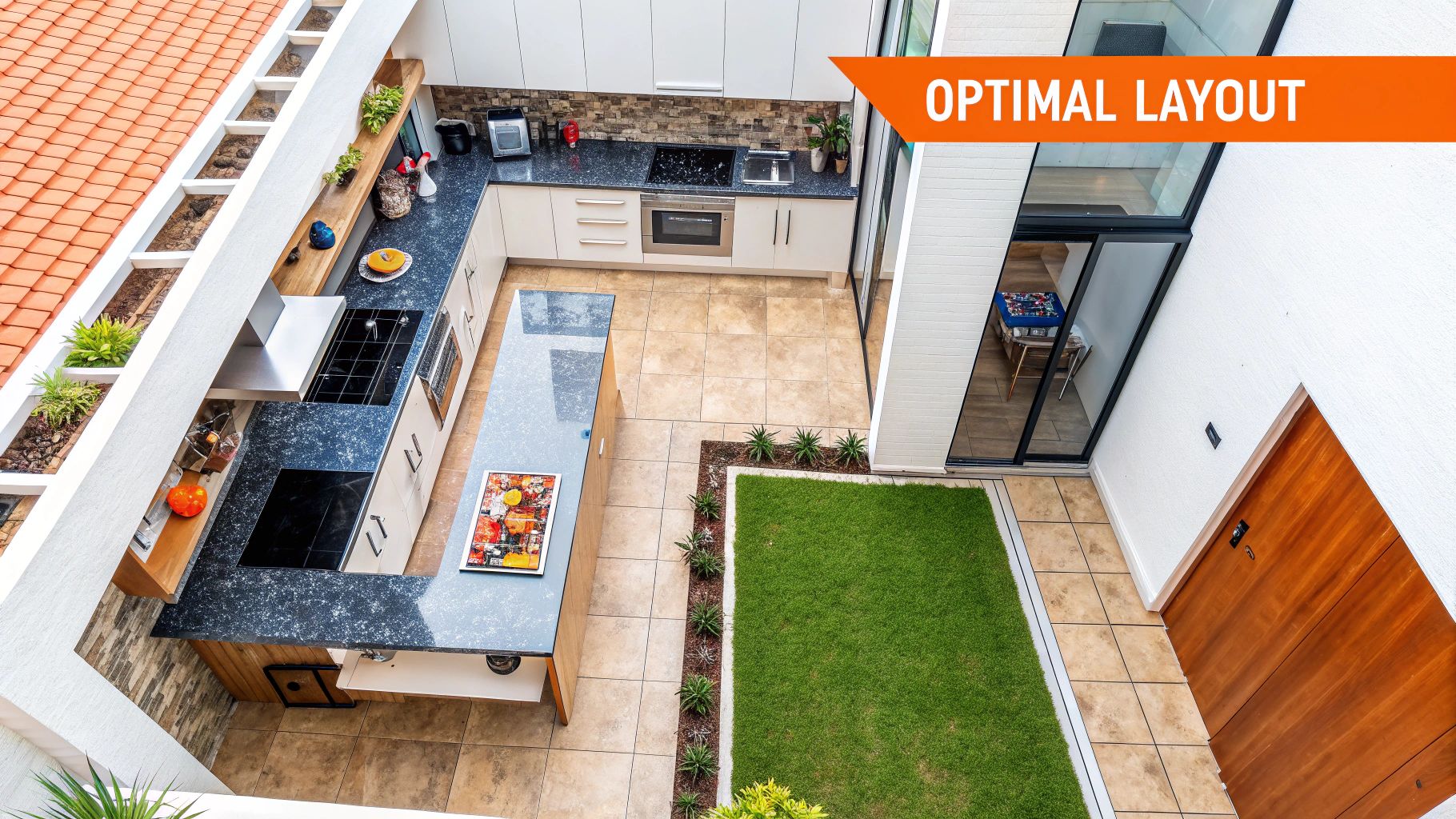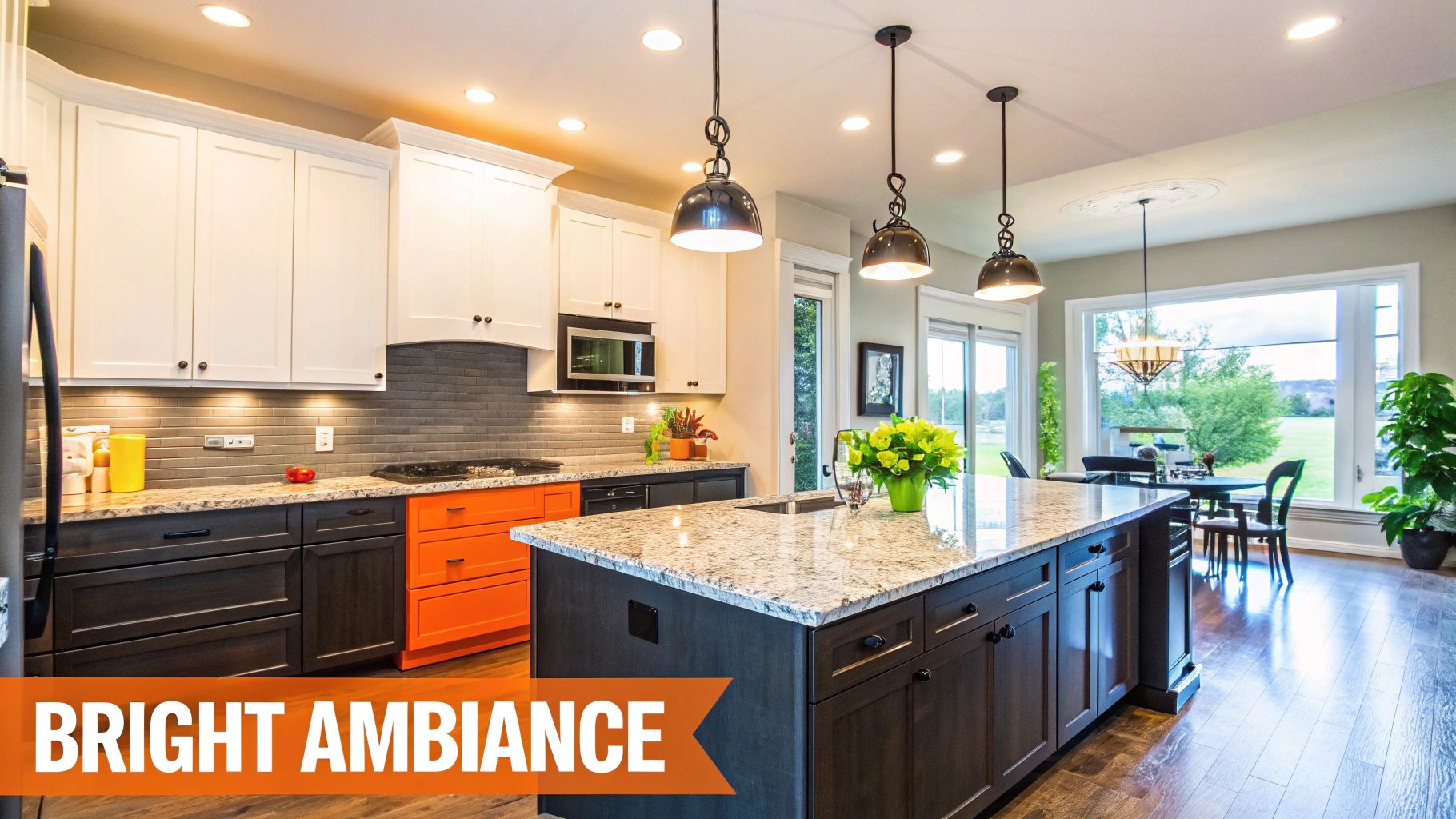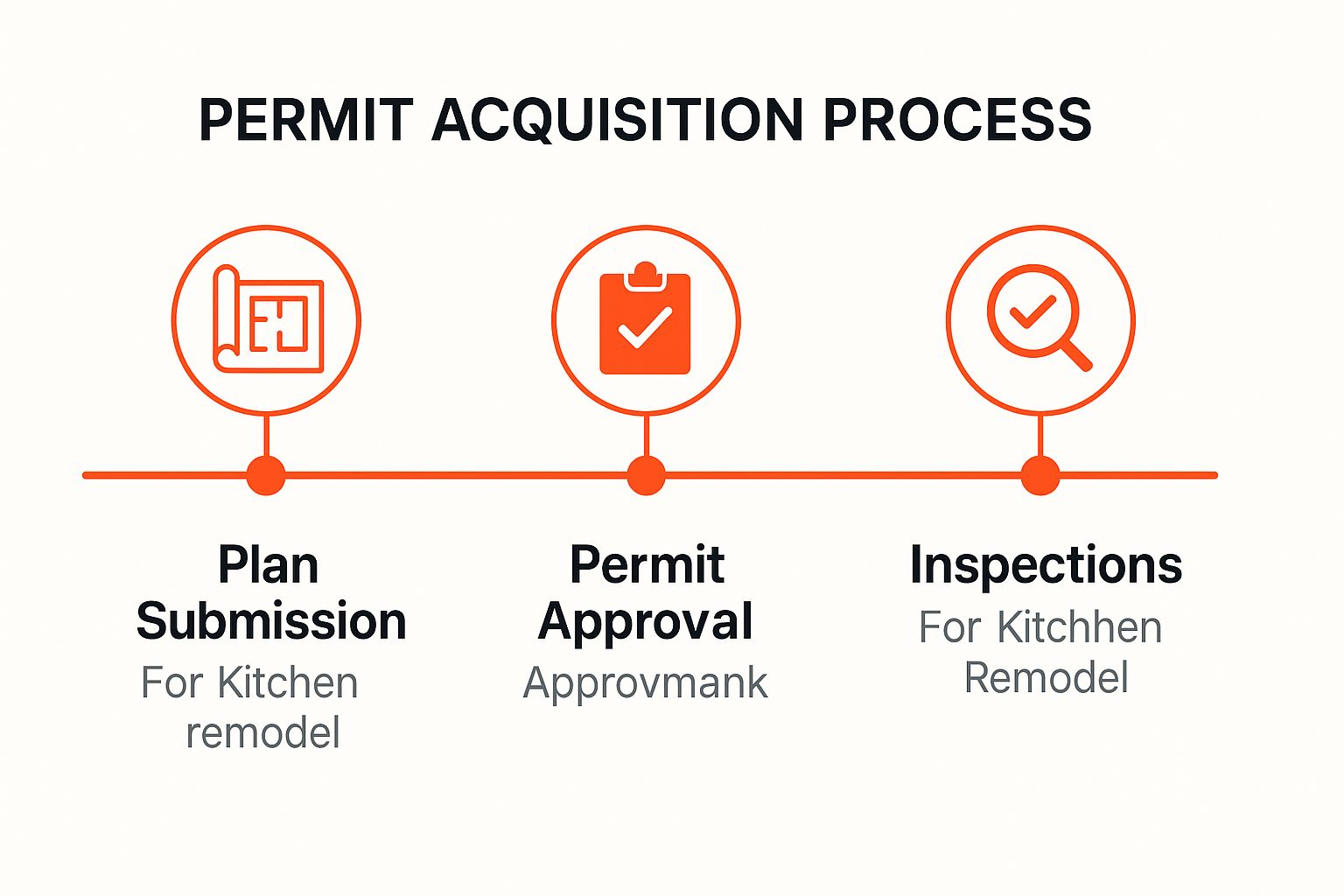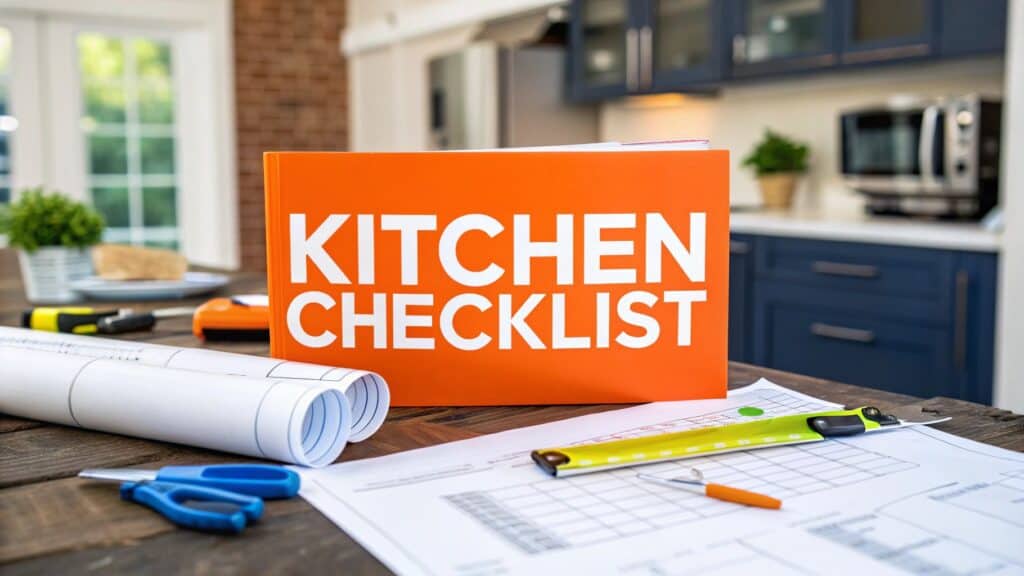Embarking on a kitchen remodel in Orange County is more than just a home improvement project; it’s a significant investment in your property’s value, daily functionality, and overall lifestyle. For discerning homeowners who expect impeccable craftsmanship and a seamless process, a detailed plan is not just helpful, it’s essential. This is where our definitive kitchen remodeling checklist becomes your most valuable tool.
As an IICRC Master Certified firm, licensed General Contractor, and a BBB Torch Award Winner for Ethics, Sparkle Restoration Services understands the nuances of high-end renovations. We’ve guided countless Orange County clients from initial concept to breathtaking completion, transforming chaotic construction sites into calm, luxurious living spaces. We’ve consolidated our deep industry knowledge into this comprehensive blueprint to ensure nothing is overlooked.
This guide is designed to empower you with the expertise needed to navigate every critical phase of your kitchen transformation. We will break down each step, from establishing a realistic budget and selecting durable materials to hiring qualified professionals and securing necessary permits. This checklist serves as your expert roadmap, providing the clarity and confidence required to manage your project efficiently, avoid costly mistakes, and achieve the sophisticated, high-end results you envision for your Southern California home. Consider this your first step toward turning your remodeling dreams into a stunning and functional reality.
1. Establish a Realistic Budget
Before a single tile is chosen or a cabinet design is sketched, the most critical step in your kitchen remodeling checklist is establishing a clear, comprehensive, and realistic budget. This financial framework is the foundation upon which every subsequent decision rests, ensuring your project remains on track without compromising quality or causing financial strain. For discerning homeowners, a well-defined budget isn’t about limitation; it’s about strategic allocation of resources to achieve a high-end result that enhances both your lifestyle and property value.
Deconstructing Your Investment
A successful budget goes far beyond a single lump-sum figure. It requires a detailed breakdown that accounts for every facet of the project. A common professional guideline allocates funds as follows:
- Cabinetry and Hardware: 30-35%
- Labor and Installation: 20-25%
- Appliances and Ventilation: 10-15%
- Countertops: 10%
- Flooring: 5-7%
- Lighting and Electrical: 5%
- Plumbing and Fixtures: 5%
- Design Fees, Permits, and Other Costs: 3-5%
Key Insight: Always include a contingency fund of 15-20% of your total budget. This isn’t for overages; it’s a non-negotiable buffer for unforeseen structural issues, material delays, or inspired design upgrades that arise mid-project. Our client-focused approach emphasizes this to ensure your peace of mind and prevent stressful financial surprises.
From Concept to Concrete Numbers
To set your budget, begin by researching typical project costs in your area. For instance, upscale kitchen renovations in Orange County can range from $75,000 to over $150,000, depending on the scope, materials, and level of customization. Understanding the various factors that influence kitchen remodeling costs in Huntington Beach and surrounding communities like Newport Beach and Irvine provides a solid benchmark. Once you have a target range, secure at least three detailed quotes from reputable, licensed General Contractors. This vital step provides clarity on market rates for labor and materials, helping you create a financial plan grounded in reality, not just aspiration.
2. Design the Optimal Kitchen Layout
Beyond aesthetics, the layout is the functional heart of your kitchen, dictating workflow, efficiency, and how you experience the space daily. A strategically designed layout is a cornerstone of any high-end kitchen remodeling checklist, transforming your room from a collection of beautiful elements into a cohesive, intuitive workspace. For discerning homeowners, the goal is a layout that supports everything from a quiet morning coffee to hosting a large dinner party with seamless grace and ergonomic precision.

Deconstructing Your Workspace
The ideal layout is deeply personal, tailored to your unique lifestyle, cooking habits, and family needs. It begins by analyzing how you move and operate within the space. Popular high-functioning layouts include:
- L-Shaped with Island: Excellent for creating an efficient work triangle while providing a central hub for prep, casual dining, and socializing—a favorite in spacious Orange County homes.
- Galley Kitchen: A highly efficient, linear design ideal for smaller spaces, which can be opened up with a peninsula to connect to an adjacent room.
- U-Shaped Kitchen: Maximizes counter and storage space on three walls, perfect for serious cooks who require ample room for appliances and prep.
- Open-Concept: Integrates the kitchen with living or dining areas, creating an expansive, airy feel well-suited for entertaining and family interaction.
Key Insight: Before committing, use painter’s tape on your floor to outline the proposed footprint of new cabinets, islands, and appliances. Walk through the space to simulate daily tasks like unloading the dishwasher or carrying a hot pot to the sink to test traffic flow and clearance. This practical step helps prevent costly design regrets.
From Concept to Concrete Plans
A successful layout considers both workflow and ergonomics. The classic “kitchen work triangle” connecting the sink, refrigerator, and range remains a valid principle for efficiency. However, modern designs often evolve this into “work zones” for prepping, cooking, and cleaning. Ensure there is adequate “landing space” (at least 15-18 inches) next to key appliances like the oven and microwave. Collaborating with a professional is essential to translate your vision into a blueprint that is both beautiful and functional. A seasoned team can help you explore the possibilities of integrated design-build services in Orange County to create a layout that perfectly marries architectural integrity with your personal style.
3. Select Quality Appliances Within Budget
Appliances are the workhorses of your kitchen, profoundly influencing its daily functionality, overall aesthetic, and energy consumption. Selecting the right models for your kitchen remodeling checklist is a critical decision that marries high performance with sophisticated design. For discerning homeowners, choosing appliances is not merely about function; it’s about curating a suite of tools that supports your culinary ambitions, integrates seamlessly into a custom design, and delivers lasting value and reliability.
Blending Performance with Design
A high-end kitchen demands appliances that deliver professional-grade results while complementing the bespoke cabinetry and countertops. The selection process requires a strategic approach that balances budget allocations with long-term goals. Key considerations include:
- Integration and Aesthetics: Will appliances be panel-ready to blend with cabinetry, or will they be stainless steel statement pieces? Consider how brands like Sub-Zero, Wolf, or Thermador align with your vision.
- Performance and Lifestyle: Evaluate your cooking habits. A professional-style gas range may be essential for an avid home chef, while a quiet, high-capacity dishwasher from a brand like Bosch is a priority for frequent entertainers.
- Energy Efficiency: Prioritize ENERGY STAR® certified models to reduce long-term utility costs and support a sustainable home environment, a key consideration for modern luxury living.
- Smart Technology: Explore appliances with Wi-Fi connectivity for remote monitoring and control, adding a layer of convenience and efficiency to your daily routine.
Key Insight: Finalize your appliance selections before finalizing your cabinet design. Precise measurements of refrigerators, ovens, and dishwashers are non-negotiable for achieving the built-in, seamless look that defines a luxury kitchen renovation. This is a pro tip we share with all our clients to ensure flawless execution.
Strategic Sourcing and Installation
Securing your chosen appliances involves more than just a purchase. Start by reading professional reviews from sources like Consumer Reports and consulting with your design-build team for their expert recommendations. They can often provide access to trade pricing or advise on package deals that offer significant savings without compromising on quality. Planning is paramount; confirm the specific electrical (e.g., 220v outlets) and plumbing requirements for each unit early in the design phase. This proactive step prevents costly rework and ensures your installation is flawless, perfectly integrating your new high-performance tools into the heart of your home.
4. Choose Durable and Appropriate Materials
With the layout and design vision established, the next pivotal stage in your kitchen remodeling checklist involves selecting the materials that will bring your space to life. This decision is a careful balance of aesthetic desire, functional necessity, and long-term performance. For the discerning Orange County homeowner, material selection is not merely about choosing a color or pattern; it’s about investing in surfaces and finishes that can withstand the rigors of daily life while retaining their luxurious appeal for years to come.
Deconstructing Your Material Palette
A high-end kitchen is a symphony of textures and finishes. Each material must be chosen for its unique properties and how it contributes to the overall design narrative. A strategic approach to material selection considers both form and function:
- Countertops: This is often the visual centerpiece. Engineered quartz (like Caesarstone) offers unparalleled durability and low maintenance, while natural stones like quartzite or marble provide timeless, one-of-a-kind elegance, albeit with more care required.
- Cabinetry: Solid wood remains a gold standard for its strength and beauty. However, high-quality wood veneers and premium laminates offer exceptional durability and a wider range of contemporary finishes.
- Backsplash: This is a prime opportunity for personality. Classic subway tile offers timeless appeal, while options like slab backsplashes, Zellige tiles, or custom mosaics can create a dramatic focal point.
- Flooring: The choice here must prioritize durability and comfort. Hardwood floors add warmth and value, luxury vinyl tile (LVT) provides excellent water resistance and durability, and porcelain tile offers endless design possibilities with robust performance.
Key Insight: Always request physical samples of your final material choices. View them in your kitchen at different times of the day to see how they interact with your home’s unique natural and artificial lighting before making a final commitment. This simple step ensures your selections will be loved for years.
From Samples to Sourcing
Once you have a general idea, it’s crucial to understand the practical implications of each choice. Consider the maintenance demands of each material; a busy family may prioritize the non-porous, stain-resistant qualities of quartz over the delicate beauty of Carrara marble. It’s also vital to verify material availability and lead times with your design-build team early in the process. Sourcing specialty or imported materials can sometimes impact project timelines, so building these considerations into your plan is essential for a seamless execution that aligns with both your lifestyle and your project schedule.
5. Plan Adequate Storage Solutions
A high-end kitchen is defined not just by its aesthetics, but by its seamless functionality. A critical component of this functionality, often overlooked until it’s too late, is meticulously planned storage. Effective storage transforms a kitchen from a beautiful but cluttered space into an organized, efficient hub of the home. For discerning homeowners, this step in the kitchen remodeling checklist is about creating intelligent, accessible systems that eliminate countertop clutter and streamline every culinary task.
Deconstructing Your Storage Needs
A truly custom storage plan begins with a comprehensive inventory of your current and future needs. It requires moving beyond standard cabinets and shelves to design solutions tailored to your lifestyle. A strategic approach involves a detailed breakdown:
- Pantry Systems: Walk-in, reach-in, or cabinet pantries with pull-out shelving and designated zones for dry goods, snacks, and bulk items.
- Drawer-Based Storage: Deep drawers for pots and pans, shallow drawers with custom dividers for utensils and cutlery, and specialized drawers for spices or knives.
- Appliance Storage: Dedicated appliance garages with built-in outlets to conceal stand mixers and toasters, or vertical tray dividers for baking sheets and cutting boards.
- Specialized Inserts: Pull-out spice racks, blind corner optimizers, trash and recycling pull-outs, and under-sink caddies to maximize every cubic inch.
Key Insight: Design for ergonomics. Place frequently used items like spices, oils, and everyday dishes between waist and shoulder height. Reserve higher and lower cabinets for less-used or seasonal items to minimize bending and reaching. Thoughtful design makes your kitchen a joy to use.
From Concept to Concrete Solutions
To translate your storage needs into a functional design, begin by decluttering and taking stock of everything you own. This process helps identify what is essential. Once you have a clear inventory, work with your designer to integrate these needs into the cabinetry layout. Exploring a portfolio of sophisticated projects, like this custom kitchen remodel in Huntington Beach, can provide tangible inspiration for how innovative storage solutions are integrated into luxury designs. This proactive planning ensures your new kitchen supports your lifestyle with unparalleled organization and ease.
6. Design Proper Lighting Plan
A truly exceptional kitchen remodel transcends beautiful cabinets and countertops; it is defined by an atmosphere that is both highly functional and warmly inviting. The secret to achieving this balance lies in a well-conceived lighting plan. Far more than just illuminating a space, a layered lighting strategy is a critical component of your kitchen remodeling checklist that shapes mood, enhances safety, and elevates the aesthetic of your entire design. For the discerning Orange County homeowner, professional lighting design is a non-negotiable element that distinguishes a standard renovation from a bespoke, luxury experience.

Deconstructing Your Illumination
An effective lighting plan integrates three distinct layers, each serving a specific purpose. This holistic approach ensures every corner of your kitchen is perfectly lit for any occasion, from intricate meal preparation to relaxed entertaining. A professional design allocates lighting as follows:
- Ambient Lighting: This is the general, overall illumination of the room, often provided by recessed cans or a central fixture. It creates a comfortable base level of light.
- Task Lighting: Focused and direct, this is crucial for work areas. Think LED strips under upper cabinets to light countertops, or pendants illuminating a kitchen island.
- Accent Lighting: This layer adds depth and drama, highlighting architectural features or decor. Examples include in-cabinet lighting for glassware or a spotlight on a piece of art.
Key Insight: Integrate smart lighting controls and dimmers for every layer. This allows you to effortlessly transition the kitchen’s ambiance from a bright, energetic workspace to a soft, intimate setting for dining and socializing with the touch of a button. This is a hallmark of modern luxury design.
From Concept to Concrete Placement
To execute a flawless lighting plan, it must be developed early in the design phase, alongside your layout and electrical plans. Begin by mapping out key work zones (prep, cooking, cleanup) and social hubs (island, dining nook). Consider how natural light from windows will interact with your plan throughout the day. For example, a well-lit kitchen in a Newport Beach home might use sleek, modern pendants over an island to complement ocean views without obstruction. Discussing these specific needs with your design-build team ensures all electrical rough-ins are placed correctly before drywall is installed, preventing costly and disruptive changes later in your project.
7. Address Plumbing and Electrical Requirements
Beneath the visible beauty of custom cabinetry and quartz countertops lies the critical infrastructure that powers a modern, high-functioning kitchen. Addressing plumbing and electrical requirements early in the planning process is a non-negotiable step in your kitchen remodeling checklist. This foundational work ensures your new space not only meets current safety codes but is also equipped to handle the demands of today’s high-performance appliances and sophisticated lighting systems, guaranteeing both safety and convenience for years to come.
Deconstructing Your Systems
A successful systems upgrade requires a meticulous plan that anticipates future needs while correcting any existing deficiencies. A professional assessment will evaluate your current capacity and outline necessary enhancements. Key considerations include:
- Dedicated Circuits: Modern, high-draw appliances like induction cooktops, double ovens, and even powerful microwaves require their own dedicated circuits to prevent overloads.
- Outlet Placement and Type: Strategically place GFCI (Ground Fault Circuit Interrupter) outlets near water sources and consider adding outlets with USB ports in areas like an island or a home command center.
- Plumbing Relocation and Upgrades: Moving a sink or adding a pot filler requires rerouting supply and drain lines. This is also the ideal time to replace old, corroded pipes to improve water flow and prevent future leaks.
- Appliance-Specific Needs: Ensure a 220V outlet is planned for an electric range, a water line is run for a refrigerator’s ice maker, and proper drainage is installed for a new dishwasher or garbage disposal.
Key Insight: Never underestimate the importance of a professional systems inspection before finalizing your layout. Discovering that your electrical panel is at capacity or that a drainpipe is incorrectly sloped after demolition has begun can lead to costly delays and significant budget overruns. A trustworthy contractor addresses this proactively.
From Blueprint to Power-Up
To properly map your kitchen’s utility needs, integrate your electrician and plumber into the design phase alongside your general contractor. When planning the plumbing for your new kitchen, specific tasks such as installing a kitchen sink require careful attention to supply lines, drainage, and fixture compatibility. Similarly, a detailed electrical plan will pinpoint the exact location for task, ambient, and accent lighting, ensuring every work zone is perfectly illuminated. Having a comprehensive understanding of your project’s infrastructure needs is essential for any high-end kitchen remodel. For more guidance, explore the technical aspects of a full-service kitchen remodel in Huntington Beach to see how experts integrate these critical systems.
8. Obtain Necessary Permits
While often viewed as a bureaucratic hurdle, securing the proper permits is a non-negotiable step in any high-end kitchen remodeling checklist. This crucial phase ensures your renovation complies with local building codes, safety regulations, and zoning laws. For discerning Orange County homeowners, permits are not an obstacle but a form of protection, safeguarding your investment, ensuring the structural integrity of your home, and preventing legal or financial complications when it comes time to sell your property.
Navigating the Permitting Process
The permit process is a formal review of your project plans by your local municipal building department. It confirms that all planned work, from electrical wiring to plumbing and structural changes, meets established safety standards. A reputable design-build firm will manage this entire process, but understanding its components is vital. Common kitchen remodel elements that require a permit include:
- Structural Alterations: Removing or relocating walls, or modifying headers and support beams.
- Electrical Work: Adding new circuits, moving outlets, or installing new hardwired lighting fixtures.
- Plumbing Modifications: Relocating a sink or dishwasher, or adding a new gas line for a cooktop.
- HVAC Changes: Altering or adding ventilation, such as a new, more powerful range hood system.
Key Insight: Attempting to bypass the permit process can lead to significant consequences, including fines, stop-work orders, and the costly requirement to tear out completed work for inspection. It can also create major issues with homeowner’s insurance and future property sales. A professional, ethical partner will never suggest skipping this step.
From Blueprint to Building Inspector
The timeline for securing permits is a critical factor to integrate into your overall project schedule. The process begins with submitting detailed architectural and structural plans to your local city office. This infographic illustrates the typical permit acquisition and inspection timeline for a kitchen remodel.

As visualized, the journey from plan submission to final inspection is a multi-stage process that requires careful planning and coordination with both municipal authorities and your construction team. Partnering with a licensed general contractor who has an established relationship with local building departments, like those in Newport Beach or Irvine, can significantly streamline this process, ensuring your project proceeds smoothly and without unnecessary delays.
9. Establish a Realistic Timeline
Just as a budget provides financial control, a well-structured timeline offers temporal command over your kitchen remodel. This detailed schedule is more than a simple calendar; it’s a strategic sequence of events that coordinates contractors, material deliveries, and inspections. For discerning Orange County homeowners, a realistic timeline is essential for managing expectations, minimizing disruption to your lifestyle, and ensuring a seamless, stress-free renovation journey from demolition to final walkthrough.
Deconstructing Your Project Sequence
A high-end kitchen remodel is a complex ballet of specialized trades. Understanding the critical path, the sequence in which tasks must occur, is key to avoiding costly delays. A typical project timeline unfolds in distinct phases:
- Phase 1: Demolition and Structural Work (1-2 weeks): Removing old components and making any changes to walls, windows, or doorways.
- Phase 2: Rough-in Work (1-2 weeks): Installing new plumbing, electrical wiring, and HVAC ductwork within the walls.
- Phase 3: Drywall and Painting (1-2 weeks): Closing up the walls, texturing, priming, and applying initial coats of paint.
- Phase 4: Cabinet and Flooring Installation (1-3 weeks): Setting base and wall cabinets, followed by the installation of your new flooring.
- Phase 5: Countertops and Backsplash (1-2 weeks): Templating, fabricating, and installing countertops, followed by the tile or slab backsplash.
- Phase 6: Final Installations (1-2 weeks): Placing appliances, connecting plumbing fixtures (sinks, faucets), and installing lighting.
Key Insight: Always factor in a time contingency buffer of 20-30% of the total estimated timeline. This accounts for permit delays, custom material fabrication lead times, and unforeseen site conditions, turning potential crises into manageable adjustments. We build this into our planning to ensure a low-stress experience for you.
From Concept to Completion Calendar
To establish an accurate timeline, start with your contractor’s initial estimate. A cosmetic update may take 2-6 weeks, while a full-gut renovation in a Newport Beach home often requires 8-12 weeks, and projects with major structural changes can extend to 16 weeks or more. Ensure all long-lead-time items, like custom cabinetry or imported tile, are ordered well before they are needed on site. Proactive planning, including setting up a temporary kitchen, is a hallmark of a well-managed project and a crucial part of any comprehensive kitchen remodeling checklist, transforming a potentially chaotic process into an organized and predictable experience.
10. Hire Qualified Professionals
With your design finalized and budget established, the single most impactful decision you will make in your kitchen remodeling checklist is selecting the right team to bring it to life. For discerning homeowners, this step transcends simply finding a contractor; it’s about assembling a team of certified, experienced, and reputable professionals who can execute your vision flawlessly. A high-end remodel is an intricate collaboration, and the quality of your team directly dictates the quality of the outcome, ensuring your significant investment is protected.
Assembling Your Expert Team
A successful luxury renovation requires a synergistic team of specialists, not just a general handyman. Each professional plays a distinct, critical role in guaranteeing safety, functionality, and aesthetic excellence. Your core team should include:
- Design-Build Firm or General Contractor: The project lead who orchestrates all trades, manages timelines, secures permits, and ensures the entire project adheres to code and your design specifications.
- Kitchen Designer: A specialist focused on optimizing layout, workflow, material selection, and ergonomics to create a space that is both beautiful and highly functional.
- Licensed Electricians and Plumbers: Non-negotiable experts for all wiring, outlet placement, appliance hookups, and plumbing installations to ensure safety and compliance.
- Specialized Installers: Depending on your material choices, you may need dedicated artisans for custom cabinetry, intricate tilework, or high-end countertop fabrication.
Key Insight: Verify that every professional holds the appropriate licenses (e.g., a CSLB license in California) and carries both liability insurance and workers’ compensation. This is your primary protection against subpar work and on-site accidents. As a licensed General Contractor, Sparkle Restoration Services provides this assurance.
Vetting for Excellence
The vetting process is where you separate the adequate from the exceptional. Begin by sourcing at least three comprehensive bids from reputable firms to compare scope, detail, and cost. Investigate their reputation through online reviews and Better Business Bureau ratings, but go deeper by requesting a portfolio and speaking directly with recent clients. A confident, high-caliber firm will readily provide references and may even arrange a visit to a completed project. Finally, ensure every detail, from payment schedules tied to milestones to material specifications, is codified in a legally sound contract. This meticulous approach ensures a seamless partnership and a result that elevates your home’s value and your lifestyle. For more information on what to look for, you can explore the principles behind quality remodeling and construction services that prioritize craftsmanship and client peace of mind.
Kitchen Remodeling Checklist Comparison
| Item | Implementation Complexity 🔄 | Resource Requirements ⚡ | Expected Outcomes 📊 | Ideal Use Cases 💡 | Key Advantages ⭐ |
|---|---|---|---|---|---|
| Establish a Realistic Budget | Moderate to High – requires detailed research | Financial planning, multiple quotes | Controlled spending, prioritized needs | All kitchen remodels needing cost control | Prevents overspending, aids negotiations |
| Design the Optimal Kitchen Layout | High – may involve structural changes | Design expertise, possible plumbing/electrical adjustments | Improved workflow, space utilization | Remodels focused on efficiency and flow | Enhances cooking efficiency, maximizes space |
| Select Quality Appliances Within Budget | Moderate – research and comparison shopping | Appliance purchasing budget | Enhanced functionality, value addition | Kitchens needing updated or energy-efficient appliances | Energy savings, improved cooking experience |
| Choose Durable and Appropriate Materials | Moderate – sourcing varied materials | Material samples, budget for premium options | Long-lasting, visually appealing kitchen | Remodels balancing aesthetics and durability | Quality lasts longer, low maintenance options |
| Plan Adequate Storage Solutions | Moderate – custom design and installation | Custom cabinetry costs, organizational tools | Better organization, clutter reduction | Kitchens lacking organized storage | Maximizes space, improves efficiency |
| Design Proper Lighting Plan | Moderate – electrical planning and fixture selection | Lighting fixtures, electrician time | Improved safety, ambiance, task lighting | Kitchens requiring layered lighting | Enhances safety, energy efficient with LED |
| Address Plumbing and Electrical Requirements | High – may involve major system upgrades | Licensed plumbers and electricians | Safety compliance, supports modern appliances | Remodels with updated appliances or layout | Ensures code compliance, prevents overloads |
| Obtain Necessary Permits | Low to Moderate – administrative processes | Time and costs for permitting | Legal compliance, protects insurance coverage | All extensive remodels requiring inspections | Ensures safety standards, maintains property value |
| Establish Realistic Timeline | Moderate – detailed scheduling and coordination | Project management tools, contractor coordination | Reduced stress, realistic completion timeframe | Projects needing phase coordination | Identifies bottlenecks, enables better planning |
| Hire Qualified Professionals | Moderate – vetting and contract negotiation | Increased labor costs | High-quality results, fewer costly mistakes | Complex remodels requiring specialized skills | Professional expertise, insured and licensed |
Partner with Orange County’s Premier Remodeling Experts
Navigating a high-end kitchen remodel is an intricate dance of creativity, logistics, and precision. As we’ve detailed throughout this comprehensive guide, success lies in mastering each critical step, from establishing a realistic budget and designing the optimal layout to selecting durable materials and securing the right permits. This kitchen remodeling checklist is more than a simple to-do list; it is a strategic blueprint for transforming the most important room in your home into a space that reflects your lifestyle and elevates your property’s value.
The journey from initial concept to final reveal is filled with countless decisions. Each choice, whether it’s the placement of task lighting over your prep area or the selection of a countertop that balances aesthetics with durability, contributes to the final masterpiece. Overlooking even a single element, such as plumbing requirements or adequate storage planning, can compromise the entire project’s functionality and finish.
From Blueprint to Reality: The Value of Expert Execution
Mastering this checklist ensures that your vision is not only beautiful but also practical, sustainable, and meticulously executed. It’s the difference between a kitchen that simply looks good and one that performs flawlessly for years to come. A well-planned remodel, guided by these principles, delivers an exceptional return on investment, enhancing your daily life and securing your home’s long-term appeal.
However, a detailed plan is only as strong as the team executing it. For discerning homeowners in Orange County, the true key to a stress-free and successful renovation is partnering with a team that embodies expertise, integrity, and a commitment to white-glove service. The complexities of coordinating skilled trades, managing timelines, and ensuring every detail meets the highest standards of craftsmanship require a seasoned, professional touch.
Key Takeaway: A successful luxury kitchen remodel is the product of two essential components: a thorough, well-defined plan like this kitchen remodeling checklist, and an expert design-build partner capable of translating that plan into a tangible, high-quality reality.
At Sparkle Restoration Services, our reputation as a BBB Torch Award Winner for Ethics and a licensed General Contractor is built on a foundation of trust and unparalleled results. We don’t just build kitchens; we create bespoke environments tailored to our clients’ unique tastes and functional needs. Our integrated design-build process eliminates the common frustrations of remodeling, providing a single point of contact and seamless accountability from the first sketch to the final walkthrough. We manage every permit, every supplier, and every craftsman, “Turning Chaos Into Calm, Fast” so you can enjoy the creative process without the logistical burden.
Your home is your most significant asset, and your kitchen is its heart. Entrust its transformation to a team that respects your investment and is dedicated to achieving perfection. By internalizing the lessons from this checklist and aligning with a premier remodeling expert, you are setting the stage for a renovation experience that is as rewarding as the stunning final result.
Ready to bring your dream kitchen to life with a team you can trust? Contact Sparkle Restoration Services for a complimentary design consultation and discover how our award-winning, client-focused approach can transform your Orange County home. Let us handle the complexities of your kitchen remodeling checklist so you can focus on the inspiration.

